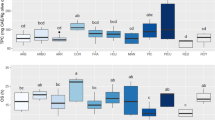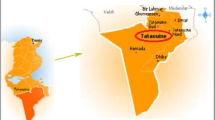Abstract
The present study aims to analyze the changes in the quality characteristics of Zakynthos olive oil, Koroneiki cv., depending on the altitude of the olive grove, at three different levels, mountainous, lowland, and coastal. Thirty-six olive oil samples, 12 from each level, were studied in terms of conventional quality indices (acidity, peroxide value and absorption coefficients), color attributes, phenolic characteristics (total phenolic content, antioxidant activity and pigment content) and volatile compounds. Results showed that the samples were of excellent quality and revealed significant variations depending on the altitude level. Total phenolic content and chlorophylls (102.25 mg GAE/kg oil and 8.74 mg PE/kg oil, respectively) recorded their highest content in mountainous level, while antioxidant activity and carotenoid content remained constant at all levels. Volatile compound analysis showed that coastal samples were richer (14.284 mg/kg) recording also the highest total amount of C6 compounds. Statistical analysis of data including Multivariate Analysis of Variance and Linear Discriminant Analysis showed that the altitude level of the olive grove plays an important role in the differentiation of single-cultivar olive oil samples. The highest classification rates were achieved for volatiles per se (83.3%) and the combination of volatiles–quality indices–phenolic characteristics (88.9%) indicating a strong effect of pedoclimatic conditions on Koroneiki cv. olive oil samples.



Similar content being viewed by others
References
Issaoui M, Delgado AM (2019). In: Ramadan MF (ed) fruit oils: chemistry and functionality. Springer Cham, Cham
Martínez-González MA, Salas-Salvadó J, Estruch R, Corella D, Fitó M, Ros E (2015) Benefits of the Mediterranean Diet: insights from the PREDIMED study. Prog Cardiovasc Dis 58:50–60
Barjol JL (2013). In: Aparicio R, Harwood J (eds) Handbook of olive oil, 2nd edn. Springer, New York
Gharbi I, Hammami M (2019). In: Ramadan MF (ed) Fruit Oils: Chemistry and Functionality. Springer Cham, Cham
Kosma I, Badeka A, Vatavali K, Kontakos S, Kontominas M (2016) Differentiation of Greek extra virgin olive oils according to cultivar based on volatile compound analysis and fatty acid composition. Eur J Lipid Sci Technol 118:849–861
Kandylis P, Vekiari AS, Kanellaki M, Grati Kamoun N, Msallem M, Kourkoutas Y (2011) Comparative study of extra virgin olive oil flavor profile of Koroneiki variety (Olea europaea var. Microcarpa alba) cultivated in Greece and Tunisia during one period of harvesting. Food Sci Technol 44:1333–1341
Longobardi F, Ventrella A, Casiello G, Sacco D, Tasioula-Margari M, Kiritsakis AK, Kontominas MG (2012) Characterisation of the geographical origin of Western Greek virgin olive oils based on instrumental and multivariate statistical analysis. Food Chem 133:169–175
Katsoyannos E, Batrinou A, Chatzilazarou A, Bratakos SM, Stamatopoulos K, Sinanoglou VJ (2015) Quality parameters of olive oil from stoned and nonstoned Koroneiki and Megaritiki Greek olive varieties at different maturity levels. Grasas Aceites 66:e067
Kosma I, Badeka A, Kontakos S, Kontominas M (2019). In: Kontominas M (ed) Authentication and detection of adulteration of olive oil, 1st edn. NovaScience Publishers Inc, New York
http://www.zakynthos.gov.gr. Accessed 10 Nov 2020
Angerosa F, Servili M, Selvaggini R, Taticchi A, Esposto S, Montedoro G (2004) Volatile compounds in virgin olive oil: occurrence and their relationship with the quality. J Chromatogr A 1054:17–31
Kiralan M, Gulcan O, Koyluoglu F, Asik Ugurlu H, Bayrak A, Kiritsakis A (2012) Effect of cultivation area and climatic conditions on volatiles of virgin olive oil. Eur J Lipid Sci Technol 114:552–557
Alowaiesh B, Singh Z, Kailis SG (2016) Harvesting time influences fruit removal force, moisture, oil content, free fatty acids and peroxide in the oil of Frantoio and Manzanilla olive cultivars. Aust J Crop Sci 10:1662–1668
Mele MA, Islam MZ, Kang HM, Giuffrè AM (2018) Pre- and post-harvest factors and their impact on oil composition and quality of olive fruit. Emir J Food Agric 30:592–603
Dabbou S, Sifi S, Rjiba I, Esposto S, Taticchi A, Servili M, Montedoro GF, Hammami M (2010) Effect of pedoclimatic conditions on the chemical composition of the Sigoise olive cultivar. Chem Biodivers 7:898–908
Ouni Y, Taamalli A, Guerfel M, Abdelly C, Zarrouk M, Flamini G (2012) The phenolic compounds and compositional quality of Chétoui virgin olive oil: effect of altitude. African J Biotechnol 11:11842–11850
Issaoui M, Flamini G, Brahmi F, Dabbou S, Hassine KB, Taamali A, Chehab H, Ellouz M, Zarrouk M, Hammami M (2010) Effect of the growing area conditions on differentiation between Chemlali and Chétoui olive oils. Food Chem 119:220–225
Uceda M, Frias L (1975) Harvest dates. Evolution of the fruit of content, oil composition and oil quality. In: Proceedings of the II Seminario Oleicola Internacional. International Olive Oil Council, Cordoba, Spain, pp 125–130
Commission E (2019) Commission Implementing Regulation (EU) 2019/1604 of 27 September 2019 amending Regulation (EEC) No 2568/91 on the characteristics of olive oil and olive-residue oil and on the relevant methods of analysis. Off J Eur Union L250:14–48
Lafka TI, Lazou AE, Sinanoglou JV, Lazos SE (2011) Phenolic and antioxidant potential of olive oil mill wastes. Food Chem 125:92–98
Minguez-Mosquera MI, Rejano L, Gandul B, Sanchez AH, Garrido J (1991) Color-pigments correlation in virgin olive oil. J Am Oil Chem Soc 68:322–337
Wiley 7 NIST05 (2005) National Institute of Standards and Technology, Mass Spectral Library, Wiley, West Sussex
SPSS (2014) IBM Corp. Released 2014. IBM SPSS statistics for windows, version 23.0 (Computer Software). Armonk, NY, USA
Field A (2009) Discovering statistics using SPSS. Sage Publications Ltd, London
International Olive Council (2015) Trade standard applying to olive oils and olive-pomace oils. COI/T.15 NC No 3/REV Madrid http://www.internationaloliveoil.org. Accessed 19 Sept 2020
Borges TH, Pereira JA, Cabrera-Vique C, Lara L, Oliveira Adelson F, Seiquer I (2017) Characterization of Arbequina virgin olive oils produced in different regions of Brazil and Spain: physicochemical properties, oxidative stability and fatty acid profile. Food Chem 215:454–462
Ouni Y, Flamini G, Issaoui M, Nabil Ben Y, Cioni PL, Hammami M, Douja D, Zarrouk M (2011) Volatile compounds and compositional quality of virgin olive oil from Oueslati variety: influence of geographical origin. Food Chem 124:1770–1776
Kosma I, Vatavali K, Kontakos S, Kontominas M, Kiritsakis A, Badeka A (2017) Geographical differentiation of Greek extra virgin olive oil from late-harvested Koroneiki cultivar fruits. J Am Oil Chem Soc 94:1373–1384
Gandul-Rojas B, Gallardo-Guerrero L, Roca M, Aparicio-Ruiz R (2013). In: Aparicio R, Harwood J (eds) Handbook of olive oil, 2nd edn. Springer, New York
Zarrouk W, Haddada FM, Baccouri B, Oueslati I, Taamalli W, Fernandez X, Lizzani-Cuvelier L, Daoud D, Zarrouk M (2008) Characterization of virgin olive oil from Southern Tunisia. Eur J Lipid Sci Technol 110:81–88
Allalout A, Krichène D, Methenni K, Taamalli A, Oueslati I, Daoud D, Zarrouk M (2009) Characterization of virgin olive oil from super intensive Spanish and Greek varieties grown in northern Tunisia. Sci Hortic 120:77–83
Ucuncuoglou D, Sivri-Ozay D (2020) Geographical origin impact on volatile composition and some quality parameters of virgin olive oils extracted from the “Ayvalık” variety. Heliyon 6:e04919
Kalogeropoulos N, Tsimidou MZ (2014) Antioxidants in Greek virgin olive oils. Antioxid 3:387–413
Blekas G, Psomiadou E, Tsimidou M, Boskou D (2002) On the importance of total polar phenols to monitor the stability of Greek virgin olive oil. Eur J Lipid Sci Technol 104:340–346
Tsimidou MZ, Mastralexi A, Özdikicierler O (2020). In: Ramadan MF (ed) Cold pressed oils. Academic Press, London
Del Giovine L, Fabietti F (2005) Copper chlorophyll in olive oils: identification and determination by LIF capillary electrophoresis. Food Control 16:267–272
Mateos R, García-Mesa JA (2006) Rapid and quantitative extraction method for the determination of chlorophylls and carotenoids in olive oil by high-performance liquid chromatography. Anal Bioanal Chem 385:1247–1254
Kalua CM, Allen MS, Bedgood DR Jr, Bishop AG, Prenzler PD, Robards K (2007) Olive oil volatile compounds flavor development and quality: a critical review. Food Chem 100:273–286
Kosma I, Vavoura M, Kontakos S, Karabagias I, Kontominas M, Kiritsakis A, Badeka A (2016) Characterization and classification of extra virgin olive oil from five less well-known Greek olive cultivars. J Am Oil Chem Soc 93:837–848
Cherfaoui M, Cecchi T, Keciri S, Boudriche L (2018) Volatile compounds of Algerian extra-virgin olive oils: Effects of cultivar and ripening stage. Int J Food Prop 21:36–49
Aparicio R, Luna G (2002) Characterisation of monovarietal virgin olive oils. Eur J Lipid Sci Technol 104:614–627
Pouliarekou E, Badeka A, Tasioula-Margari M, Kontakos S, Longobardi F, Kontominas MG (2011) Characterization and classification of Western Greek olive oils according to cultivar and geographical origin based on volatile compounds. J Chromatogr A 1218:7534–7542
Angerosa F (2002) Influence of volatile compounds on virgin olive oil quality evaluated by analytical approaches and sensor panels. Eur J Lipid Sci Technol 104:639–660
Giuffrè AM, Capocasale M, Macrì R, Caracciolo M, Zappia C, Poiana M (2020) Volatile profiles of extra virgin olive oil, olive pomace oil, soybean oil and palm oil in different heating conditions. LWT Food Sci Technol 117:108631
Karagoz SG, Yilmazer M, Ozkan G, Carbonell-Barrachina ÁA, Kiralan M, Ramadan MF (2017) Effect of cultivar and harvest time on C6 and C5 volatile compounds of Turkish olive oils. Eur Food Res Technol 243:1193–1200
Tanouti K, Serghini-Caid H, Sindic M, Wathelet JP, Bouseta A, Elamrani A (2012) Volatile compounds profiles of virgin olive oils produced in the eastern Morocco: oxidative stability and sensory defects. J Food Res 1:194–206
Morales MT, Luna G, Aparicio R (2005) Comparative study of virgin olive oil sensory defects. Food Chem 91:293–301
Kesen S, Kelebek H, Selli S (2013) Characterization of the volatile phenolic and antioxidant properties of monovarietal olive oil obtained from cv Halhali. J Am Oil Chem Soc 90:1685–1696
Bubola KB, Krapac M, Lukić I, Sladonja B, Autino A, Cantini C, Poljuha D (2014) Morphological and molecular characterization of Bova olive cultivar and aroma fingerprint of its oil. Food Technol Biotech 52:342–350
Ranalli A, Angerosa F (1996) Integral centrifuges for olive oil extraction—the qualitative characteristics of product. J Am Oil Chem Soc 73:417–422
Kiritsakis A (1998) Flavor components of olive oil. A review. J Am Oil Chem Soc 75:673–681
Vichi S, Pizzale L, Conte L, Buxaderas S, Lopez-Tamames E (2003) Solid-phase microextraction in the analysis of virgin olive oil volatile fraction: characterization of virgin olive oils from two distinct geographical areas of northern Italy. J Agric Food Chem 51:6572–6577
Author information
Authors and Affiliations
Contributions
Conceptualization: AVB and ISK; methodology: ST and ISK; software: ST and ISK; formal analysis: ST; investigation: ST and ISK; data curation: ST; writing—original draft preparation: ISK and AVB; writing—review and editing: AVB and ISK; supervision: AVB; funding acquisition: AVB.
Corresponding author
Ethics declarations
Conflict of interest
The authors declare no conflict of interest.
Compliance with ethical requirements
This article does not contain any studies with human or animal subjects.
Additional information
Publisher's Note
Springer Nature remains neutral with regard to jurisdictional claims in published maps and institutional affiliations.
Rights and permissions
About this article
Cite this article
Theodosi, S., Kosma, I.S. & Badeka, A.V. Quality characteristics of Koroneiki olive oil from Zakynthos island (Greece) and differentiation depending on the altitude level. Eur Food Res Technol 247, 1235–1248 (2021). https://doi.org/10.1007/s00217-021-03705-1
Received:
Revised:
Accepted:
Published:
Issue Date:
DOI: https://doi.org/10.1007/s00217-021-03705-1




